Toshiba Portege R835: Less Ultra, More Notebook
by Dustin Sklavos on March 30, 2012 11:35 AM EST- Posted in
- Laptops
- Intel
- Toshiba
- Sandy Bridge
- Notebooks
Battery Life
Where the Toshiba Portege R835 really benefits from Sandy Bridge and excels over its predecessor is in running time on the battery. Toshiba lists the battery life for the R835 as approximately nine hours, a hurdle we were actually able to clear pretty easily at idle.
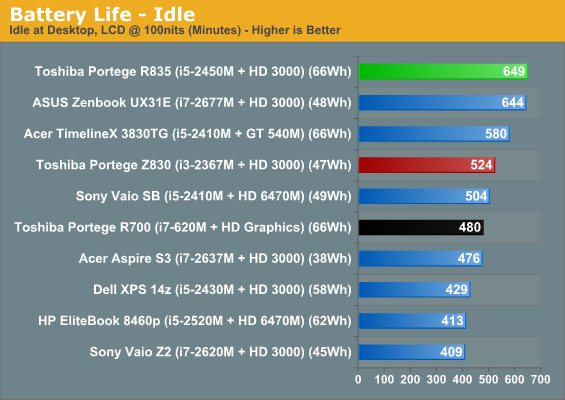
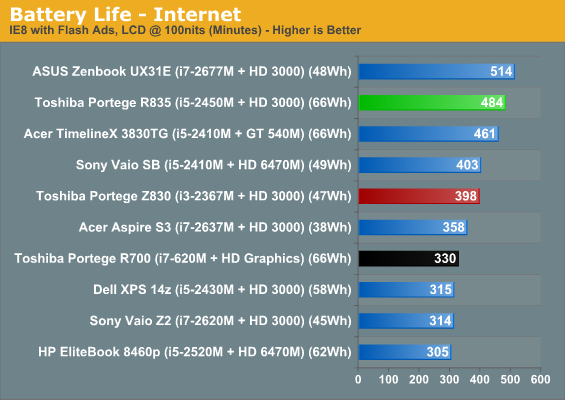
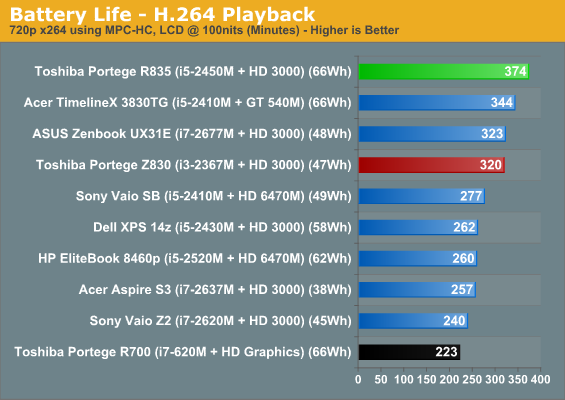
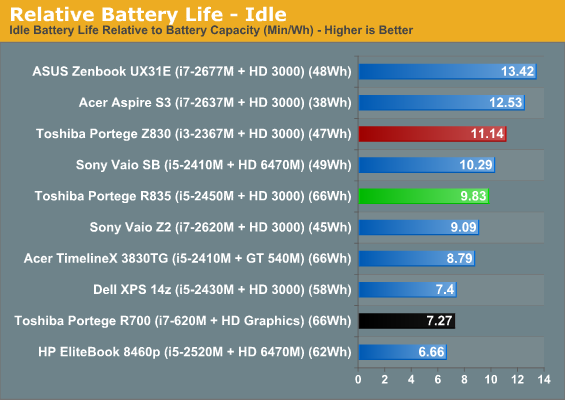
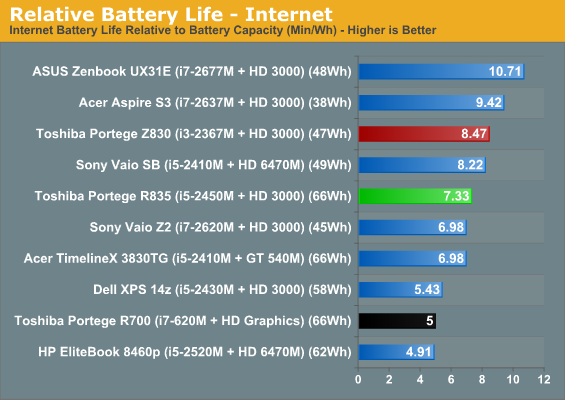
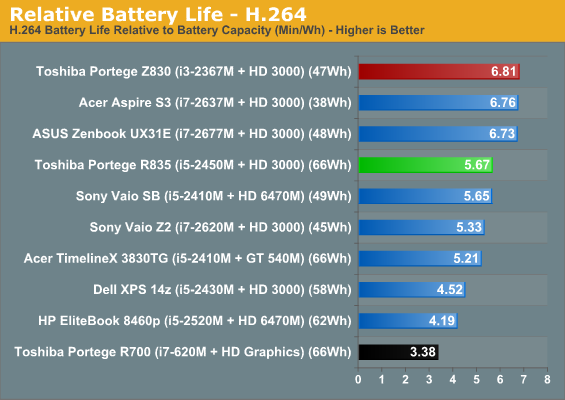
From our test results it's reasonable to assume an end user could hit that nine hour mark if they're willing to sacrifice some display brightness, or if they turn off the wireless once in a while. The Portege R835 also again demonstrates something we've been aware of for a while now: Sandy Bridge is just plain more power efficient than Arrandale. Given we're essentially looking at an updated R700, Sandy Bridge vs. Arrandale ends up with Sandy Bridge offering 35% more idle battery life, 47% more Internet battery life, and a massive 68% more video playback battery life. I makes us wonder how much further Intel can take things with Ivy Bridge, but we'll find out soon enough.
Heat and Noise
Fortunately, the high-pitched whine of the fan noise in many ultrabooks and particularly machines like Sony's Vaio Z2 isn't replicated in the Portege R835; Toshiba's notebook, even under heavy load, isn't actually that obtrusive.

Ignoring HWMonitor misreading the CPU model number, we can see there's a very good reason why fan noise isn't a huge issue with the Portege R835: the processor is basically cooking itself. This is a situation that's basically inexcusable and prevents me from making a recommendation full-stop. I was concerned thermals would prevent the i5-2450M from hitting its turbo clocks consistently after seeing these results, but apparently it's not an issue...the chip just runs very hot in this notebook.
While it's true modern processors take care of themselves to avoid burning out, I still can't help but feel like these kinds of thermals are a warranty call waiting to happen. Once dust starts accumulating in that fan it's going to be game over. This heat doesn't directly translate to the keyboard or the bottom surface of the notebook, but it's there and worthy of concern. Anecdotally, we've seen several older laptops that erred on the side of silence rather than cooling that developed serious issues over time—Jarred in fact just helped someone with a Core 2 Duo laptop that was shutting down and running horribly slow thanks to dust buildup. If you do buy a laptop like this, we definitely recommend regular dust cleanouts with compressed air, at least a couple times per year.










81 Comments
View All Comments
TrackSmart - Friday, April 13, 2012 - link
I have a Toshiba R705. Basically the same laptop, right down to the cooling system design. When running heavy-duty processes (30min of straight number crunching) my CPU core temperatures usually stay in the mid-70s. That's more than 25C below the recommended thermal limit for my processor (105C).I can't imagine any normal usage case, even heavy duty usage, where I would ever get near 105C. I'm guessing the cooling design is okay for all 'normal' usage scenarios, even heavy-duty usage.
That being said, I think that putting all of the intake vents on the bottom of the system is a really dumb idea. If you stream movies with the bottom of the laptop on a bed or sofa - look out! It's going to get toasty in there...
jigglywiggly - Friday, March 30, 2012 - link
please keep talking about lcd quality, I bought my sager np8130 (p151hm1) when you guys spoke about the LCD, it was fairly good and it was great performance for the price and dual link dvi for my 120hz displayhexanerax - Saturday, March 31, 2012 - link
How difficult is it to write a PPI agnostic app? ( to those not in the know,all elements of the UI should appear exactly the same physical size on all monitor resolutions meaning a high ppi display UI looks awesome and this low res junk that manufacturers are hawking will end).Hi res support has to be coded into the os and done right. I have enough problems with un-clickable buttons and unreadable text due to poor dpi scaling in some poorly written apps. Getting correct PPI information from the panel and scaling display elements to actual physical dimensions would be great, allowing users to really see the difference and cough up the extra dough if inclined.
Writing this on a great 1900 x 1200 17" LCD on my Dell Precision M6300 ( never upgraded due to the 16:9 fetish in most product lines.
hexanerax - Saturday, March 31, 2012 - link
$ for $ , an SSD will translate to better user experience than a higher clocked processor for most normal usage scenarios. For those looking for a fast, low priced system, adding a 40 GB SSD and going for a lower clocked cpu or lesser cores will be a better option than a 500 GB 5400 RPM HDD with a high frequency processor. Enthusiast or not an SSD is no longer an option. I can understand using a Mechanical drive for critical data considering the issues that SSDs have had in the past but if you are buying a budget laptop, how critical is the data you are storing? Think cloud storage + SSD for the best experience. Buy an external HDD.On a system with a Corsair Force F120.
jabber - Saturday, March 31, 2012 - link
I don't need more than two USB ports (to be honest I can get by with one).I don't need a Firewire port.
I don't really need a HDMI or D-Sub port either.
I can go without Bluetooth.
That should be nearly enough to get a decent screen instead.
Yeah so one or two USB ports, a gigabit ethernet port and the power port are all I need.
Mumrik - Saturday, March 31, 2012 - link
I'm out...Pylon757 - Saturday, March 31, 2012 - link
Judging from the last picture on the 2nd page, the body appears to be magnesium alloy, not plastic. Mag alloy feels a lot like plastic (especially when painted) since its thermal conductivity is extremely poor and thus doesn't feel cold to the touch (unlike say, aluminum found on Apple's devices)hexanerax - Sunday, April 1, 2012 - link
Just for the record :-http://www.jsw.co.jp/en/mg_f/mg_mg_f/mg_mg_chare.h...
It probably feels less cold because it is conducting heat from the system outwards.
The paint probably has more to do with this feeling than the thermal conductivity of the metal. Aluminum is generally left unpainted ( polished, brushed ) or anodize in color which leaves the thermal properties unchanged.
Mygaffer - Sunday, April 1, 2012 - link
The last time many consumers have seen a monitor with decent image quality was when they were using a CRT.If more consumers could see a side by side of your average TN panel and some of the amazing IPS and PVA panels out there a lot more people would seek out the better monitors. Right now people just don't know any better.
I use two monitors at home, the Dell 3007wfp-HC and a Yamakasi Catleap Q270 (27" S-IPS, same panel as the Apple Cinema display). Both are S-IPS panels, both are very high resolution, and both are amazing. To go back to some lower resolution TN panel now would make me want to claw out my eyes.
Luckily my HP laptop has a very good TN panel in it that even has good viewing angles. One thing that will have to improve a little bit for the high resolution displays to be a good fit for everyone will be better font scaling. Windows 7 has fairly decent support for it and modern browsers also allow some control but it still needs to be improved.
ThreeDee912 - Sunday, April 1, 2012 - link
For better or worse, ultrabooks are coming down in price, and are still using crappy panels.Except for Delta E, and compared to the high-end Sony, it seems like the MacBook Air line from last year still beats most of the panels in these new Ultrabooks:
http://www.anandtech.com/show/5259/ultrabook-head-...